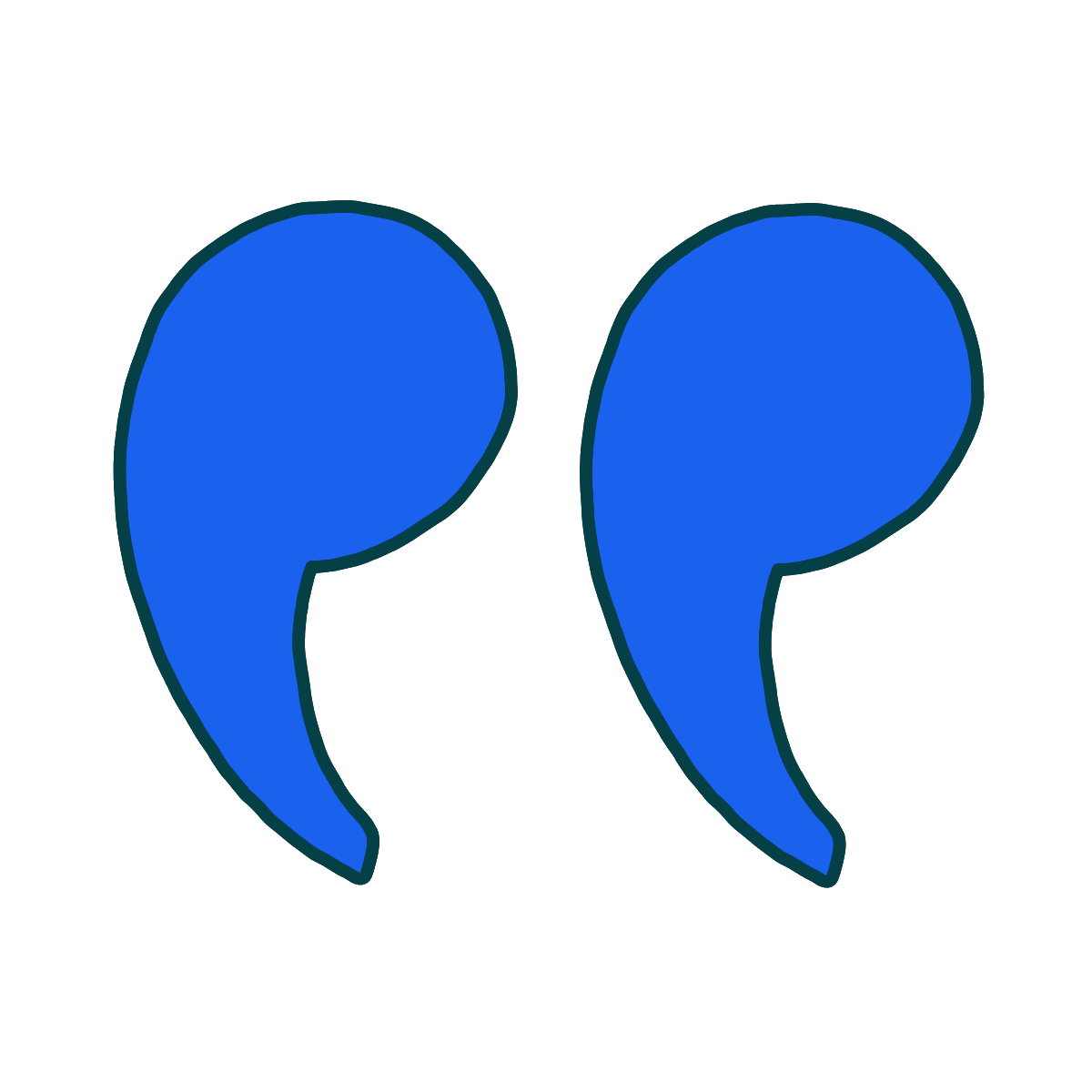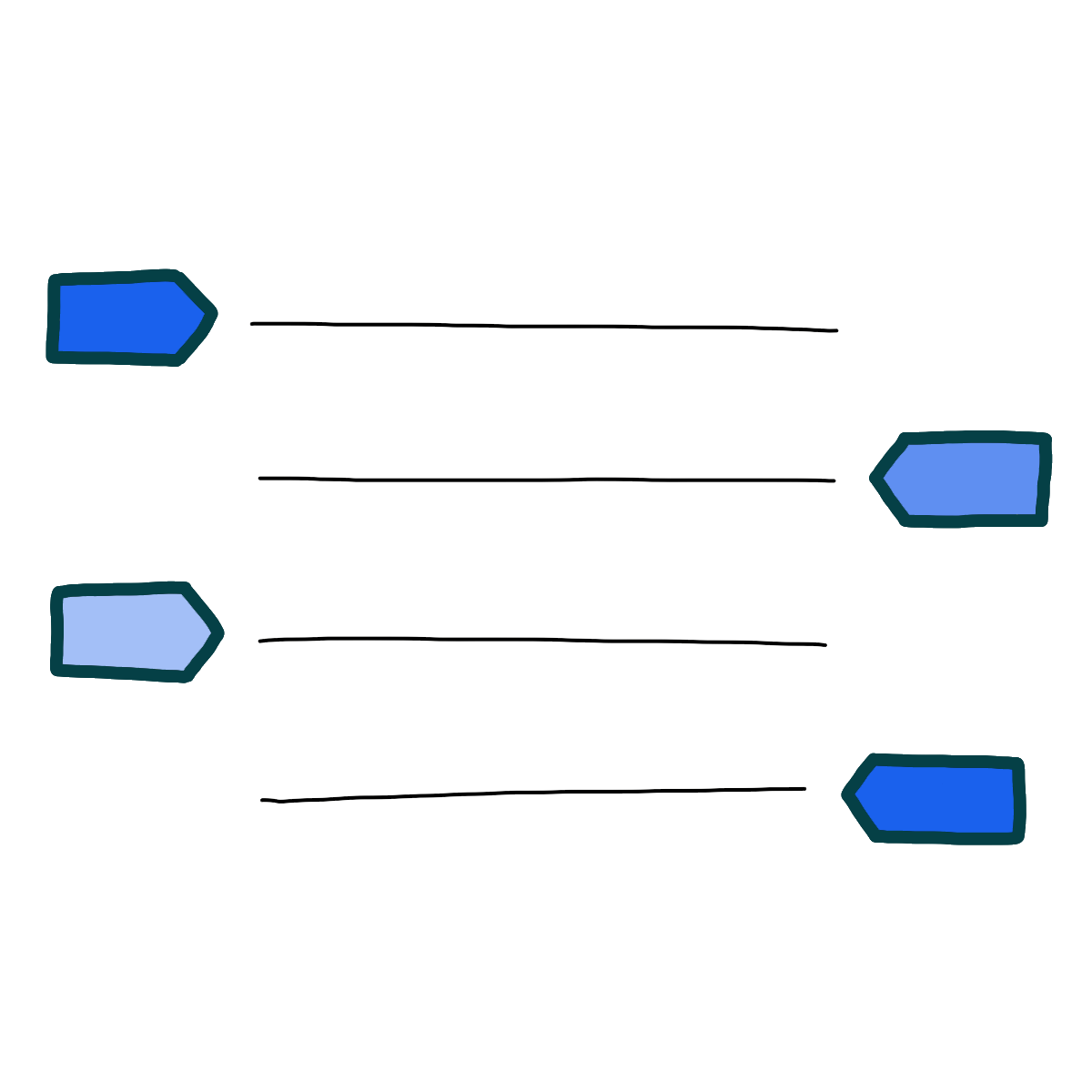The Full Text of “The Walrus and the Carpenter”
1The sun was shining on the sea,
2Shining with all his might:
3He did his very best to make
4The billows smooth and bright—
5And this was odd, because it was
6The middle of the night.
7The moon was shining sulkily,
8Because she thought the sun
9Had got no business to be there
10After the day was done—
11"It's very rude of him," she said,
12"To come and spoil the fun!"
13The sea was wet as wet could be,
14The sands were dry as dry.
15You could not see a cloud, because
16No cloud was in the sky:
17No birds were flying overhead—
18There were no birds to fly.
19The Walrus and the Carpenter
20Were walking close at hand;
21They wept like anything to see
22Such quantities of sand:
23"If this were only cleared away,"
24They said, "it would be grand!"
25"If seven maids with seven mops
26Swept it for half a year,
27Do you suppose," the Walrus said,
28"That they could get it clear?"
29"I doubt it," said the Carpenter,
30And shed a bitter tear.
31"O Oysters, come and walk with us!"
32The Walrus did beseech.
33"A pleasant walk, a pleasant talk,
34Along the briny beach:
35We cannot do with more than four,
36To give a hand to each."
37The eldest Oyster looked at him,
38But never a word he said:
39The eldest Oyster winked his eye,
40And shook his heavy head—
41Meaning to say he did not choose
42To leave the oyster-bed.
43But four young Oysters hurried up,
44All eager for the treat:
45Their coats were brushed, their faces washed,
46Their shoes were clean and neat—
47And this was odd, because, you know,
48They hadn't any feet.
49Four other Oysters followed them,
50And yet another four;
51And thick and fast they came at last,
52And more, and more, and more —
53All hopping through the frothy waves,
54And scrambling to the shore.
55The Walrus and the Carpenter
56Walked on a mile or so,
57And then they rested on a rock
58Conveniently low:
59And all the little Oysters stood
60And waited in a row.
61"The time has come," the Walrus said,
62"To talk of many things:
63Of shoes—and ships—and sealing-wax—
64Of cabbages—and kings—
65And why the sea is boiling hot—
66And whether pigs have wings."
67"But wait a bit," the Oysters cried,
68"Before we have our chat;
69For some of us are out of breath,
70And all of us are fat!"
71"No hurry!" said the Carpenter.
72They thanked him much for that.
73"A loaf of bread," the Walrus said,
74"Is what we chiefly need:
75Pepper and vinegar besides
76Are very good indeed—
77Now if you're ready, Oysters dear,
78We can begin to feed."
79"But not on us!" the Oysters cried,
80Turning a little blue.
81"After such kindness, that would be
82A dismal thing to do!"
83"The night is fine," the Walrus said.
84"Do you admire the view?
85"It was so kind of you to come!
86And you are very nice!"
87The Carpenter said nothing but
88"Cut us another slice:
89I wish you were not quite so deaf—
90I've had to ask you twice!"
91"It seems a shame," the Walrus said,
92"To play them such a trick,
93After we've brought them out so far,
94And made them trot so quick!"
95The Carpenter said nothing but
96"The butter's spread too thick!"
97"I weep for you," the Walrus said:
98"I deeply sympathize."
99With sobs and tears he sorted out
100Those of the largest size,
101Holding his pocket-handkerchief
102Before his streaming eyes.
103"O Oysters," said the Carpenter,
104"You've had a pleasant run!
105Shall we be trotting home again?"
106But answer came there none—
107And this was scarcely odd, because
108They'd eaten every one.
-
“The Walrus and the Carpenter” Introduction
-
"The Walrus and the Carpenter" originally appeared in Lewis Carroll's 1871 book Through the Looking-Glass, in which the twins Tweedledum and Tweedledee recite the poem to Carroll's protagonist, Alice. In the poem, which is an example of Victorian "nonsense" verse, the titular Walrus and the Carpenter go for a walk together on a beach. They come across a bed of "Oysters," whom they invite to accompany them on their stroll—only to later eat the whole lot, the Walrus dramatically sobbing all the while. Despite being filled with silliness (including talking animals and shoe-wearing mollusks), the poem makes some subtle points about greed, power, and hypocrisy.
-
-
“The Walrus and the Carpenter” Summary
-
The speaker describes a strange scene: the personified sun shines down on the sea with all his strength, trying as best he can to brighten up the waves—despite the fact that it's the middle of the night.
Meanwhile, the moon is pouting as she shines because she thinks that the sun doesn't belong here, given that the day is over; the night is her territory, yet he rudely invades it and ruins her good time.
The speaker then sets the scene for the rest of the poem: the sea is very wet while the sands on the shore are very dry. The sky above is empty, with no clouds or birds in sight.
The Walrus and the Carpenter walk down the beach together. For reasons the speaker never explains, the amount of sand on the beach brings them to tears. It would be really great, they think, if it could all just be cleared away.
The Walrus asks his companion if he thinks that seven maids sweeping the beach with mops for half a year could clear away all that sand. The Carpenter responds he doesn't think so while crying out a single, resentful tear.
The pair then comes across some oysters. The Walrus encourages the shellfish to join them on their walk, insisting that it will be an enjoyable stroll filled with enjoyable conversation along the salty beach. He claims that they don't have room for more than four oysters, however, because he and the Carpenter intend to each help two along.
The oldest oyster in the oyster bed remains silent while looking back at the Walrus. He then winks and shakes his head sadly, declining the invitation.
However, four younger oysters eagerly scurry forward to join them. They've freshened up for the occasion, tidying their coats and cleaning their faces and shoes—despite the fact that they don't have feet.
Another group of oysters joins them, and then another. Then a whole bunch of oysters starts rushing forth, skipping through the foamy surf while scurrying out of the ocean.
After the group continues on for about a mile, the Walrus and the Carpenter decide to rest on a low rock, leaving the oysters to line up before them.
The Walrus suggests they discuss a series of nonsensical topics—everything from shoes to the wax used to seal letters, to vegetables and monarchs. He wonders why the ocean is boiling and if pigs have wings.
But the oysters aren't ready to talk and request a brief rest, since most of them are exhausted from the walk and need to catch their breath. The Carpenter assures the oysters that they're in no rush and can wait, for which the oysters are grateful.
The Walrus then starts listing items they require for a meal, including some bread, pepper, and vinegar—all things that go very well with oysters. He asks the oysters if they're ready to eat.
The oysters, fearing that they might be on the menu, protest that this would be a very rude thing to do—but the Walrus brushes off their concern (and perhaps tries to distract them) by pointing out the beauty of the night.
The Walrus declares how much he's enjoyed the oysters' company. The Carpenter, meanwhile, just rudely asks them to cut another slice of bread, frustrated that he's already had to ask them multiple times.
The Walrus admits that he feels some regret for tricking the oysters like this, especially since they made them scurry so far and fast along the beach. But the Carpenter just criticizes the amount of butter on the bread.
The Walrus insists that he feels deeply for the unfortunate oysters and weeps while selecting the juiciest ones. In fact, he cries so much that he has to hold his handkerchief to his face.
The Carpenter calls out to the oysters, declaring that they've had a nice time and better start scurrying back home. Of course, no one answers him, given that he and the Walrus have eaten all of their companions.
-
-
“The Walrus and the Carpenter” Themes
-
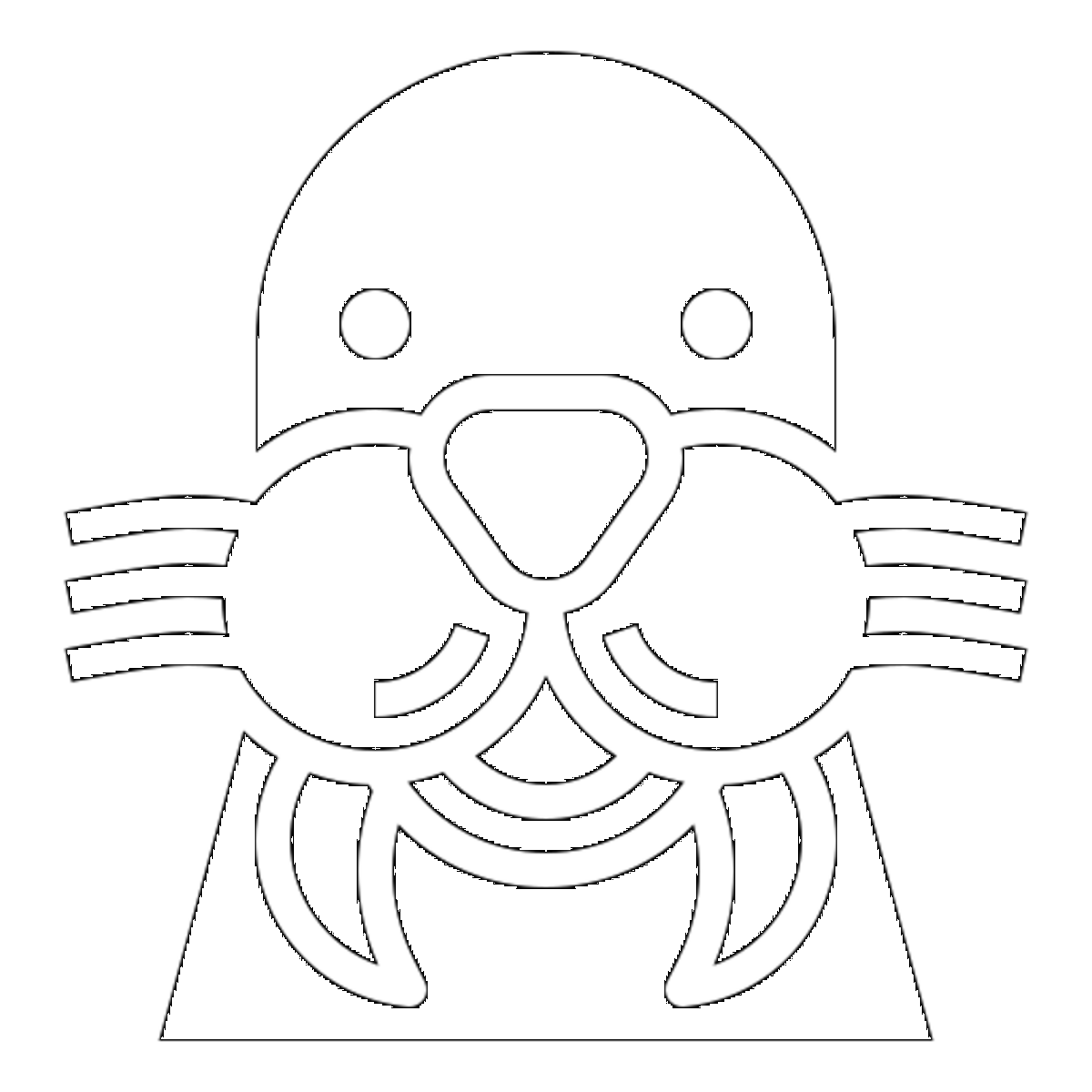
Power, Entitlement, and Greed
Although Lewis Carroll's "The Walrus and the Carpenter" is an example of Victorian "nonsense" verse—it features a talking walrus and shoe-wearing oysters, after all—it also subtly critiques entitlement, the abuse of power, and greed. The sun invades the moon's territory without any thought for her feelings, for example, and the titular Walrus and Carpenter end up eating all of the polite, helpless little "Oysters" who accompany them on their walk. In addition to simply entertaining readers, then, the poem illustrates how creatures tend to act in accordance with their desires when they have the power to do so—even when those desires actively harm other creatures.
Throughout the poem, the sun shines despite the fact that it's nighttime. Even though the night sky is the moon's territory, the sun (gendered male) encroaches on it simply because he can. The moon, which is gendered female, "thought the sun / Had got no business to be there / After the day was done." Nevertheless, the sun shines with "all its might"—aggressively imposing on the scene regardless of what's right, and despite the moon's wishes. Even though the sun doesn't belong in the nighttime world, in this poem, he has the power to invade the moon's territory, so he does. While the speaker doesn't explicitly pass judgment on this behavior, the moon's displeasure is obvious. The sun's exercise of power is portrayed as an unfair invasion of the moon's space.
Similarly, the Walrus and the Carpenter indulge themselves at the Oysters' expense, suggesting that power will gobble up what it can, when it can. They invite the young Oysters to accompany them on their stroll, then eat them all. This morbid end to an otherwise whimsical poem demonstrates the pair's selfishness, as well as their willingness to betray their new friends in service of their own appetites. When the Walrus proposes dinner, the Oysters beg him and the Carpenter not to dine on them. Yet although the Walrus claims to regret "trick[ing]" them, he and the Carpenter eat them anyway. For the powerful, it seems, gratification of one's appetites comes before morality.
The initial disagreement between the sun and the moon foreshadows this later betrayal, which demonstrates a more serious form of entitlement. Because the Walrus and the Carpenter are more powerful than the Oysters who accompany them on their walk, they can not only trick them but consume them. Due to their position above the Oysters in the food chain or hierarchy of creatures, they feel their desires outweigh the Oysters', and they act accordingly. The poem might suggest that both in the “real world” and in the “nonsense world” of this poem, power works the same way.
- See where this theme is active in the poem.
-

Hypocrisy, Sentimentality, and Cruelty
Throughout "The Walrus and the Carpenter," both Walrus and Carpenter express outsized emotion while acting with ruthless cunning. Their dramatics help give the poem its "nonsense" quality while distracting the audience, the Oysters, and perhaps even themselves from their dark and selfish motives. Sentimentality, the poem suggests, is often a hypocritical mask for cruelty.
The Walrus and Carpenter gush and emote about matters large and small, even when it makes no sense to do so. They weep "bitter[ly]" over the presence of sand on the beach they're enjoying and "beseech" rather than simply invite the Oysters to join them. They even declare that they "cannot do with more than four / To give a hand to each"—a statement that they seemingly forget completely as more clueless young Oysters join their party.
Eventually, it becomes clear that their grand outward emotions disguise their heartlessness—from others and perhaps even from themselves. The Walrus implores the Oysters to join him and the Carpenter for "A pleasant walk, a pleasant talk, / Along the briny beach," disguising the outing as an adventure among friends. The Carpenter even accommodates the Oysters' request to "wait a bit" before the group begins to talk so that they can rest. The Walrus claims to "weep for" the Oysters even while eating them, holding a "pocket-handkerchief / Before his streaming eyes" as he sorts out the largest ones. Both he and the Carpenter ignore the Oysters’ fears of being eaten, brushing them aside with meaningless pleasantries while continuing with their plan.
The one character who sees through their hypocrisy is the "eldest Oyster," and the poem subtly encourages his kind of wary realism. When the Walrus and the Carpenter invite the Oysters to join them, he doesn’t respond to their tricks and flattery. Instead, he "wink[s] his eye, / And sh[akes] his heavy head." He chooses to remain in the oyster-bed where he knows he's safe rather than blindly trusting the pair and placing his fate in their hands. The hopeful, naive young Oysters are taken in by the Walrus and the Carpenter's perceived kindness, but the old Oyster knows better. At the end of the day, he's one of the only Oysters left—the Walrus and the Carpenter eat all those who accompany them on their walk.
The poem illustrates how, in the "nonsense" world just as in the real world, sentimentality can be easily faked to disguise cruel motives.
- See where this theme is active in the poem.
-
-
Line-by-Line Explanation & Analysis of “The Walrus and the Carpenter”
-
Lines 1-12
The sun was shining on the sea,
Shining with all his might:
He did his very best to make
The billows smooth and bright—
And this was odd, because it was
The middle of the night.
The moon was shining sulkily,
Because she thought the sun
Had got no business to be there
After the day was done—
"It's very rude of him," she said,
"To come and spoil the fun!"The first two stanzas of "The Walrus and the Carpenter" set up the absurd, self-contradictory "nonsense" world of the poem. While it seems the speaker is narrating a normal scene—the sun "shining on the sea, / Shining with all his might"—it quickly becomes apparent that something's not right. It is, in fact, the middle of the night!
The diacope of the word "shining" emphasizes the force of the sun's rays, which certainly shouldn't be out at this hour. Nevertheless, out they are, making the "billows smooth and bright." In other words, the sun's light illuminates the swirling water below. The bold /b/ alliteration here ("billows"/"bright") evoke's the sun's eagerness to shine.
Note that the poem personifies both the sun and the moon here: the speaker refers to them using male and female pronouns, respectively. The moon even has an opinion about what's happening, remarking that "It's very rude of him" (him being, of course, the sun) "To come and spoil the fun!" She's "shining sulkily," pouting as her light pours down, miffed that the sun is hanging out where he has "no business" being.
The sun's decision to trespass into the moon's territory also sets the thematic tone for the rest of the poem, which, despite its silliness, makes some real points about hierarchy and power. Even though it's not fair to the moon, the sun follows his desires with no regard for her feelings; later in the poem, the Walrus and the Carpenter will mirror his actions in their treatment of the vulnerable Oysters.
These stanzas establish the poem's form: "The Walrus and the Carpenter" consists of sestets, or six-line stanzas, in which the second, fourth, and sixth lines rhyme. This creates the rhyme scheme ABCBDB. The poem also alternates between lines of iambic tetrameter and iambic trimeter. Odd-numbered lines include four iambs (poetic feet with a da-DUM rhythm), while even-numbered lines have just three iambs:
The sun | was shi- | ning on | the sea,
Shining | with all | his might:
He did | his ve- | ry best | to make
The bil- | lows smooth | and bright—The meter is steady but not so perfect that it feels rigid. Notice, for example, the trochee that starts line 2: "Shining." Overall, the poem's predictable, bouncy meter and rhyme scheme add to its light-hearted tone.
-
Lines 13-24
The sea was wet as wet could be,
The sands were dry as dry.
You could not see a cloud, because
No cloud was in the sky:
No birds were flying overhead—
There were no birds to fly.
The Walrus and the Carpenter
Were walking close at hand;
They wept like anything to see
Such quantities of sand:
"If this were only cleared away,"
They said, "it
would
be grand!"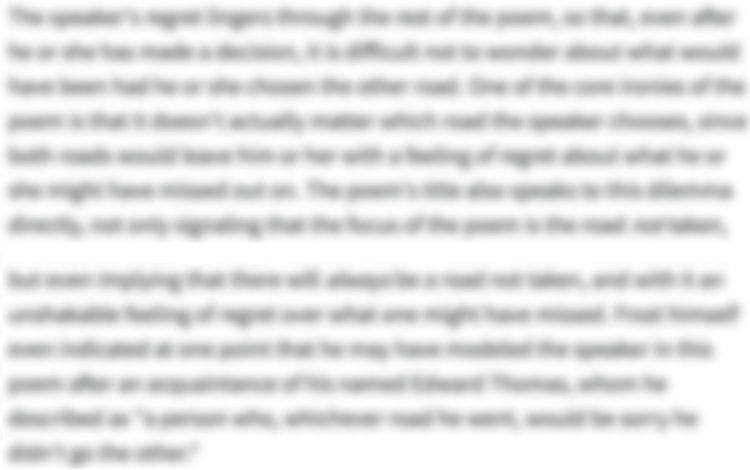
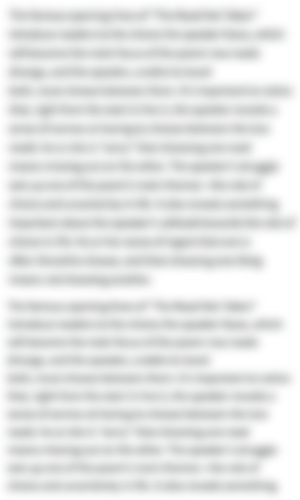
Unlock all 270 words of this analysis of Lines 13-24 of “The Walrus and the Carpenter,” and get the Line-by-Line Analysis for every poem we cover.
Plus so much more...
Get LitCharts A+ -
Lines 25-36
"If seven maids with seven mops
Swept it for half a year,
Do you suppose," the Walrus said,
"That they could get it clear?"
"I doubt it," said the Carpenter,
And shed a bitter tear.
"O Oysters, come and walk with us!"
The Walrus did beseech.
"A pleasant walk, a pleasant talk,
Along the briny beach:
We cannot do with more than four,
To give a hand to each." -
Lines 37-48
The eldest Oyster looked at him,
But never a word he said:
The eldest Oyster winked his eye,
And shook his heavy head—
Meaning to say he did not choose
To leave the oyster-bed.
But four young Oysters hurried up,
All eager for the treat:
Their coats were brushed, their faces washed,
Their shoes were clean and neat—
And this was odd, because, you know,
They hadn't any feet. -
Lines 49-60
Four other Oysters followed them,
And yet another four;
And thick and fast they came at last,
And more, and more, and more —
All hopping through the frothy waves,
And scrambling to the shore.
The Walrus and the Carpenter
Walked on a mile or so,
And then they rested on a rock
Conveniently low:
And all the little Oysters stood
And waited in a row. -
Lines 61-72
"The time has come," the Walrus said,
"To talk of many things:
Of shoes—and ships—and sealing-wax—
Of cabbages—and kings—
And why the sea is boiling hot—
And whether pigs have wings."
"But wait a bit," the Oysters cried,
"Before we have our chat;
For some of us are out of breath,
And all of us are fat!"
"No hurry!" said the Carpenter.
They thanked him much for that. -
Lines 73-84
"A loaf of bread," the Walrus said,
"Is what we chiefly need:
Pepper and vinegar besides
Are very good indeed—
Now if you're ready, Oysters dear,
We can begin to feed."
"But not on us!" the Oysters cried,
Turning a little blue.
"After such kindness, that would be
A dismal thing to do!"
"The night is fine," the Walrus said.
"Do you admire the view? -
Lines 85-96
"It was so kind of you to come!
And you are very nice!"
The Carpenter said nothing but
"Cut us another slice:
I wish you were not quite so deaf—
I've had to ask you twice!"
"It seems a shame," the Walrus said,
"To play them such a trick,
After we've brought them out so far,
And made them trot so quick!"
The Carpenter said nothing but
"The butter's spread too thick!" -
Lines 97-108
"I weep for you," the Walrus said:
"I deeply sympathize."
With sobs and tears he sorted out
Those of the largest size,
Holding his pocket-handkerchief
Before his streaming eyes.
"O Oysters," said the Carpenter,
"You've had a pleasant run!
Shall we be trotting home again?"
But answer came there none—
And this was scarcely odd, because
They'd eaten every one.
-
-
“The Walrus and the Carpenter” Poetic Devices & Figurative Language
-
Anthropomorphism
Throughout this poem, several figures are anthropomorphized: the sun, the moon, the Walrus, and the Oysters. This device fits in with the conventions of Victorian "nonsense" verse: talking animals and heavenly bodies make the narrative a lot more whimsical and surreal.
The poem begins by treating both the sun and moon almost like a bickering brother-sister pair. The sun proudly, boldly, does "his very best" to illuminate the world below—despite the fact that it's nighttime! The moon, rather understandably, is irked by this invasion into her domain. She believes that the sun has "no business" hanging around after dark and says, "It's very rude of him [...] To come and spoil the fun!"
The poet, Lewis Carroll, clearly knows this is all very silly; his speaker seems to repeatedly wink at the reader, pointing out how "odd" it is that the sun is shining in the middle of the night or that the eager little Oysters wear neat and tidy shoes despite not having "any feet."
Still, despite the silliness, this anthropomorphism also serves a thematic point. Anthropomorphizing the poem's non-human figures (in other words, everyone except for the presumably human Carpenter) allows the speaker to introduce some very human-seeming conflicts and power imbalances into the story. The sun shines in the middle of the night without regard for the moon's feelings or boundaries, while the moon "sulkily" criticizes his rudeness. The Walrus is capable of both animal appetite and human subterfuge—able to trick the Oysters into enthusiastically joining him and the Carpenter—but the Oysters are also able to beg for mercy and underscore the unfairness of their condition. The anthropomorphism in this poem allows the sun and the Walrus to knowingly abuse their power, but it also evokes pity for the victims of these abuses.
- See where this poetic device appears in the poem.
-
End-Stopped Line


Unlock all 154 words of this analysis of End-Stopped Line in “The Walrus and the Carpenter,” and get the poetic device analyses for every poem we cover.
Plus so much more...
Get LitCharts A+ -
Alliteration
-
Repetition
-
Pun
-
Assonance
-
-
“The Walrus and the Carpenter” Vocabulary
Select any word below to get its definition in the context of the poem. The words are listed in the order in which they appear in the poem.
- Billows
- Sulkily
- Grand
- Briny
- Frothy
- Sealing-wax
- Chiefly
- Dismal
- Streaming
Billows-
A billow is another word for a wave. In this case, the sun is trying to shine down upon the ocean as hard as possible—making the waves "smooth and bright"—even though it's the middle of the night.
- See where this vocabulary word appears in the poem.
-
Form, Meter, & Rhyme Scheme of “The Walrus and the Carpenter”
-
Form
"The Walrus and the Carpenter" consists of 18 sestets, or six-line stanzas. Each stanza alternates between lines of iambic tetrameter and iambic trimeter and follows an ABCBDB rhyme scheme. As such, these sesters look a lot like ballad stanzas, albeit with two extra lines at the end (ballad stanzas are quatrains).
The ballad stanza is a common, musical form, often seen in nursery rhymes or hymns. The poem's steady, familiar rhythms make it sound musical and memorable while also helping to maintain some order within this nonsensical world.
-
Meter
"The Walrus and the Carpenter" alternates between lines of iambic tetrameter and iambic trimeter. An iamb is a poetic foot with an unstressed-stressed syllable pattern; tetrameter means there are four such feet per line (eight syllables total) while trimeter means there are three (six syllables total).
Although there are subtle deviations from this meter throughout the poem, they don't disrupt the overall sense of nursery rhyme-like security that the poem's predictable rhythm provides. Take lines 1-2:
The sun | was shi- | ning on | the sea,
Shining | with all | his might:Line 1 features perfect iambic tetrameter, but the first foot of line 2 is a trochee (stressed-unstressed). This opening stress evokes the force of the sun's rays before the poem falls back into a steady iambic pattern.
-
Rhyme Scheme
"The Walrus and the Carpenter" follows a consistent rhyme scheme across its 18 sestets (six-line stanzas):
ABCBDB
The specific rhyme sounds change in each stanza (in the first stanza, for example, the "B" end rhyme is set by the word "might," while in the second stanza, it's set by the word "sun"). This is an expansion of the rhyme scheme of a ballad stanza, which has just four lines (ABCB). The pattern is common in both hymns and nursuery rhymes, its familiar cadence filling the poem with easy, memorable music.
-
-
“The Walrus and the Carpenter” Speaker
-
The speaker of "The Walrus and the Carpenter" doesn't seem to be particularly invested in the events of the poem: rather, they narrate everything as if they were watching it happen from a distance. Although they don't explicitly comment on the character of any of the figures who appear, the speaker does intersperse some of their own subtle opinions/sets the poem's tone through their specific word choices. For example, the use of a word like "sulkily" in describing the moon's reaction to the sun's invasion of her space might suggest that the speaker finds the whole conflict ridiculous. The speaker's description of the Walrus and the Carpenter's overdramatic reaction to the amount of sand on the beach captures a similar sense of ironic distance.
It's also important to note that the speaker doesn't seem to be shocked by any of the absurd goings-on in their world (they casually note the midnight sun and the Oysters' feet-free shoes as "odd"). They're aware that this world is very strange, and they say as much to the reader. This creates a kind of intimacy, encouraging the reader to trust the speaker and just go along with the story without getting caught up in the parts of it that don't make sense.
-
-
“The Walrus and the Carpenter” Setting
-
This poem is set in an absurd, "nonsense" world that bears some similarities to Victorian England (e.g., the existence of "sealing-wax" and "kings"). This is a world where animals and celestial objects can talk, a Walrus can befriend a Carpenter, and mollusks wear freshly-brushed coats and clean little shoes.
The poem more specifically takes place on a sandy, salty beach where the sea is, predictably, "wet" and the sand is "dry." The sun is somehow shining in the middle of the night and, apart from the sun and the moon, the sky is otherwise empty; there are no birds or clouds in sight.
The Walrus and the Carpenter are walking along this beach together, dramatically lamenting the vast "quantities of sand." There's so much sand that not even "seven maids with seven mops" sweeping "for half a year" could get rid of it all—a fact that makes the Carpenter "shed a bitter tear." There are also plenty of "Oysters" on this beach, who scurry "through the frothy waves" of the sea to join the Walrus and the Carpenter on their walk along the shore. The silliness and strangeness of the beach add to the poem's humor and lighthearted tone.
-
-
Literary and Historical Context of “The Walrus and the Carpenter”
Literary Context
"The Walrus and the Carpenter" originally appeared in Lewis Carroll's novel Through the Looking-Glass (the sequel to Alice's Adventures in Wonderland). Through the Looking-Glass is a whimsical children's book famously centered around the protagonist Alice's fantastical adventures in a world called Wonderland. She encounters a series of strange characters upon her journey, including the twins Tweedledum and Tweedledee, who recite "The Walrus and the Carpenter" to her in the fourth chapter of the novel.
Alice tries to figure out which of the selfish protagonists she prefers but is confused when the twins question the motivations and meanings behind both the Walrus and the Carpenter's behavior. After analyzing the poem, she quickly realizes that both of the characters are intended to be self-serving and unlikeable. But like the Walrus and the Carpenter themselves, the twins engage Alice in confusing, nonsensical, and even disturbing "philosophical" conversation to distract her!
This poem is an example of Victorian "nonsense" verse. Broadly, nonsense literature is characterized by whimsical humor, eccentric characters, and the use of poetic elements that both facilitate and hinder meaning. For example, while this poem is a kind of narrative ballad with a strict meter and rhyme scheme, the actions it describes are extremely silly—even random-seeming. Along with his contemporary Edward Lear, Carroll pioneered the nonsense genre in the mid-1800s. His mixtures of prose and poetry are conventionally structured but packed with wordplay, absurd characters, and logically impossible situations.
Although many scholars have attempted to question or "debunk" the symbolism of the Walrus and the Carpenter's species and profession respectively (with some theorizing that the Carpenter represents Jesus, or that the pair functions collectively as a representation of British imperial invasion upon the helpless Oysters), the ridiculousness and whimsy of Carroll's Alice series muddles these potential deep readings of the poem. The truth is that Carroll's illustrator, Sir John Tenniel, was allowed to choose between the words "butterfly," "carpenter," and "baronet"—all three options fit the poem's meter and rhyme scheme.
Historical Context
Lewis Carroll (1832-1898) wrote in mid-19th-century England, during the Victorian era (1837-1901). This was a time of rapidly accumulating wealth and economic progress, as a result of both the British Empire's colonial expansion and the Industrial Revolution. Population increased almost everywhere in the British Isles (except in Ireland during the Great Famine), and London became a booming metropolis. Conditions for the working class, however, remained awful. Many poorer people, including children, worked long hours in unsanitary factories and mines, which were often breeding grounds for infectious diseases.
Although literature thrived thanks to the general increase in wealth and population, much of it focused on the social problems connected to both, particularly income inequality and the widening gap between social classes. The idea that literature could include nonsensical humor was still a foreign concept to many people, yet it was in the realm of whimsy and laughter that Carroll thrived—perhaps partly in reaction to the struggles of the time.
-
More “The Walrus and the Carpenter” Resources
-
External Resources
-
Lewis Carroll (Poetry Foundation) — An overview of Carroll's life and work with particular attention paid to his relationship with Victorian traditions.
-
"Nonsense, or Anti-Capitalist Allegory?" — In its "Poem of the Week" series, The Guardian dives into some potential meanings behind the nonsense of "The Walrus and the Carpenter."
-
The Poem Out Loud. — Listen to a reading of the poem.
-
A Brief Biography of Lewis Carroll — Learn more about Carroll's life, as well as his interest in logic and satire.
-
-
LitCharts on Other Poems by Lewis Carroll
-






